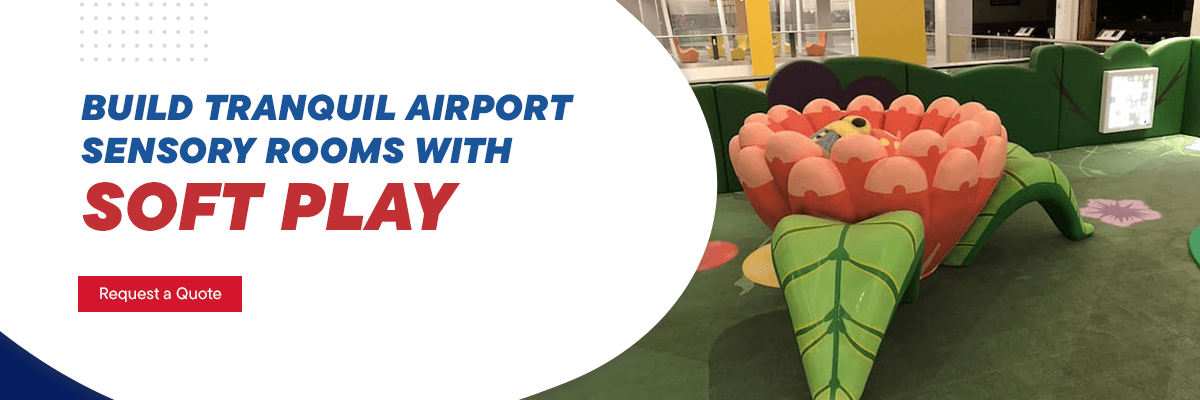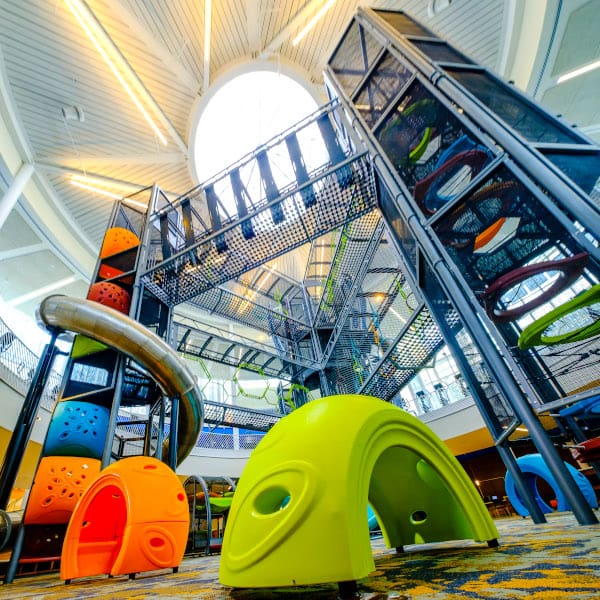Adding Sensory Rooms to Airports
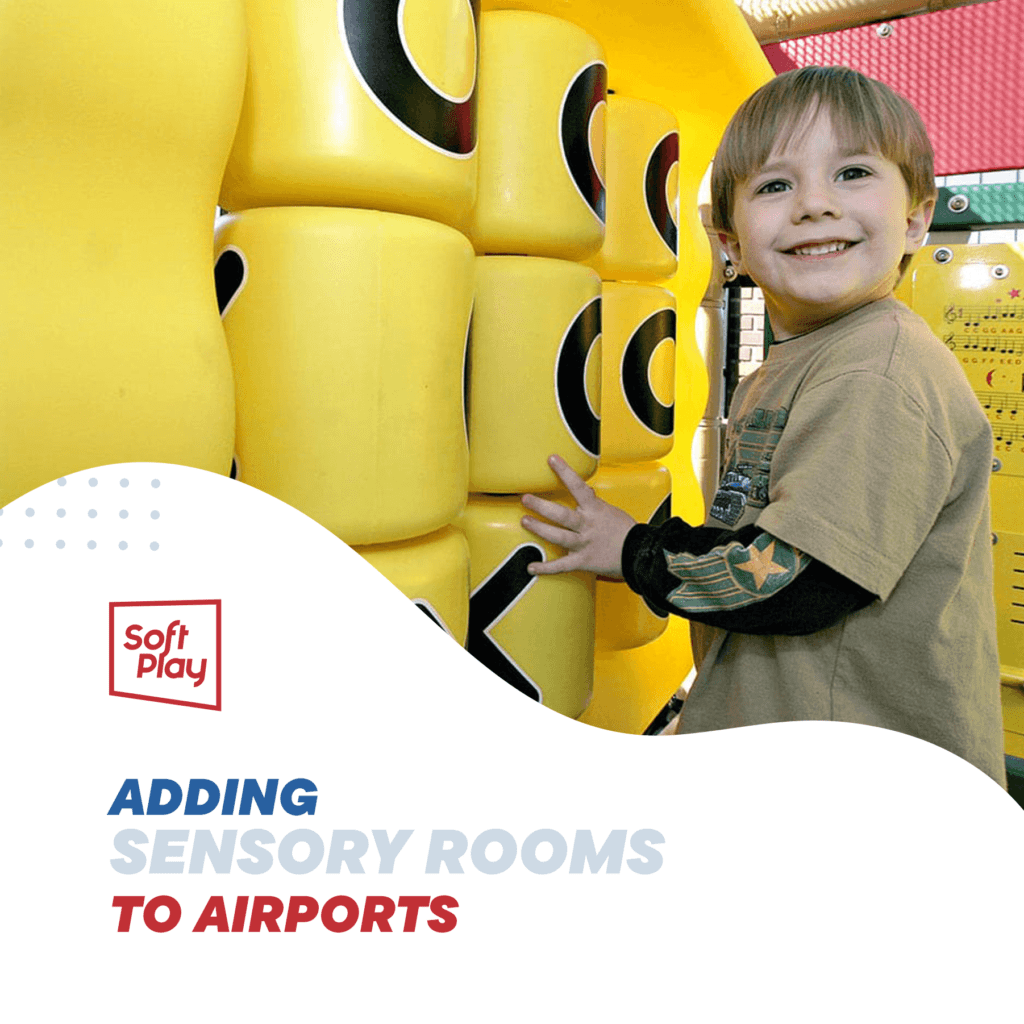
Adding Sensory Rooms to Airports
Airports can be busy, loud and stressful, especially for people with sensory processing difficulties. The loudspeaker announcements, constant beeps and lack of activities can be stressful for some and underwhelming for others. Sensory rooms provide a space for individuals with sensory processing difficulties to gather their thoughts, find stimulation or just enjoy a moment of peace and silence.
Learn more about why sensory rooms are beneficial for airports and how to create the space.
What Is a Sensory Room at an Airport?
An airport sensory room is designed to offer a sense of calm and relaxation to individuals with sensory overload or sensory processing difficulties. It offers a safe space for people to decompress if they’ve been overwhelmed by the busyness of the airport. Investing in a sensory room can provide a comfortable space that makes flying easier for people with these conditions:
- Sensory processing disorder (SPD): People with this condition may misinterpret sensory information, causing challenges with processing sounds, smells, touch, sights or tastes.
- Post-traumatic stress disorder (PTSD): Individuals with PTSD can become overwhelmed or panicked by certain sensory inputs. A sensory room can offer them a space to de-stress and decompress.
- Autism spectrum disorder (ASD): Approximately 9 out of 10 people with autism process sensory information differently, either requiring less or more stimulation to feel comfortable.
- Attention deficit hyperactivity disorder (ADHD): Kids with ADHD may seek more sensory input to de-escalate and release frustrations. Families will be especially grateful for this in an airport setting, where the kids may get particularly disgruntled with waiting in queues.
Sensory rooms are popping up in more public spaces, even in university libraries like Penn State, to help neurodivergent students deal with their stress and anxiety. In airports, sensory rooms can help adults and kids unpack their stresses and offer safe spaces for neurodivergent people.
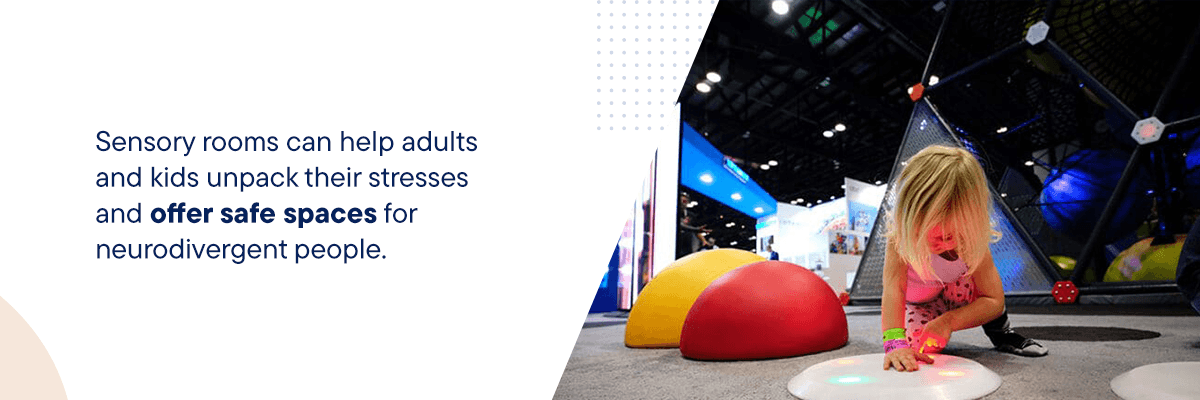
What Are the Benefits of Sensory Rooms in Airports?
Sensory rooms offer many benefits for passengers by creating a supportive environment for individuals with sensory sensitivities. They also benefit the airport by creating a more accessible and welcoming space for people, improving the company’s reputation and making room for a larger demographic. Here are the top benefits:
- Enhances focus: Airports with sensory rooms can help people with sensory difficulties compose themselves and work out important boarding information like the gate directions in a quiet area.
- Relieves stress and overwhelm: Neurodivergent people may not always feel comfortable with airports. The beeping, the announcements, the sound of bags being wheeled everywhere and the sight of so many people moving around can be anxiety-inducing. Sensory rooms allow them to escape the busyness, breathe and relax their minds before or after a flight. Kids who feel overwhelmed in airports can ground themselves in sensory rooms, making them feel more comfortable.
- Encourages socialization: With the hustle and bustle of the airport, most people don’t have time to socialize. Some kids may also lack social stimulation when stuck at the airport for hours. Sensory rooms can offer them the chance to engage with others in a controlled environment.
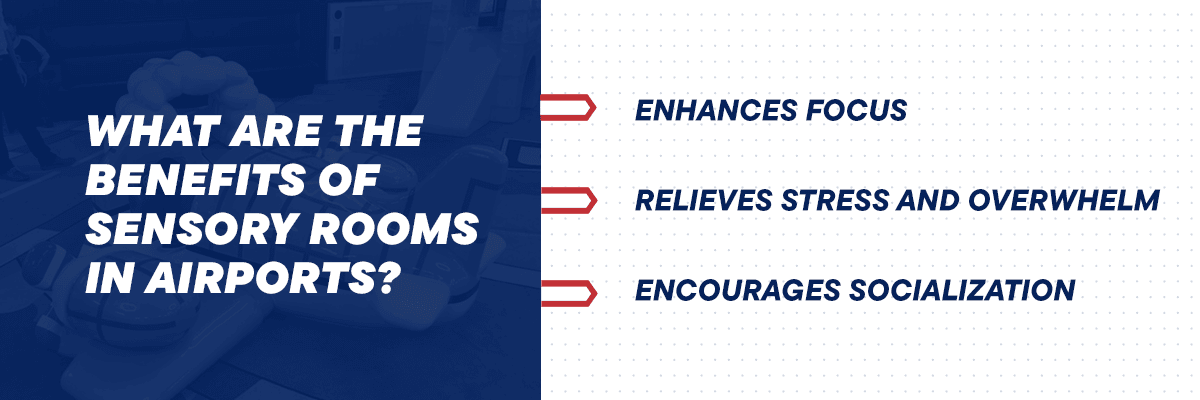
How to Design Sensory Spaces in Airports
Designing sensory spaces doesn’t necessarily require high-level construction or extensions. For example, Rogers State University converted a storage room into a sensory room. Sensory spaces are about adding the right elements to create a peaceful environment for individuals to relax. Follow these steps when equipping airports with sensory rooms:
1. Follow a Sensory Space Checklist
Sensory spaces need to be calming and relaxing yet stimulating — what does that actually mean? Here’s a checklist to demystify what should actually go into a sensory space in an airport:
- Keep the space scent-free: Check that there are no strong scented fragrances like hand soaps or air fresheners in the space.
- Minimize visual clutter: While the space should have visual stimulation, avoid visual clutter by ensuring it’s always clean and organized.
- Use solid colors: For calming sensory spaces, stick to solid colors instead of flashy designs.
- Include quiet zones: It’s important to include a calm zone in the sensory space for individuals who need a peaceful, confined space to gather their thoughts and calm their emotions.
- Provide stimulation: Some individuals may need more stimulation to feel comfortable, so providing equipment that offers visual, physical and sound stimulation is also crucial.
- Create active seating: Provide functional and interactive seating that encourages stimulation, comfort and textural differences.
- Provide maps in the sensory space: Include a map of the airport in or near the sensory area so people who struggle to focus in crowded places or loud spaces can easily plan their way around the airport.
2. Decide on the Type of Sensory Space
Sensory rooms can exist to provide stimulation, reduce stimulation, offer grounding spaces and just provide a fun space to unwind. Here are three different types of sensory spaces that work well for an airport:
Kids’ Sensory Room
At an airport, kids are likely to become restless or overstimulated by all the sounds, lights and busyness. Create a kids’ sensory room with equipment that offers them physical, visual and social stimulation, like the STOMP interactive play attraction, which requires less space and provides maximum fun and stimulation.
Consider that some kids may seek a quiet area that’s away from all the busyness of the main play area. Include a calm area that’s separate from the busy areas but still in view for parents to monitor their kids. Even in small play areas, the right design will offer a quiet space. One example is the Soft Play® Tap-A-Tune zone, which is open at the front but provides a sense of privacy and calming stimulation for kids.
Dark Sensory Room
Dark sensory rooms have bright, fluorescent colors set up against a dark background to offer visual stimulation and relief from bright light. A good example of this aesthetic is the Kennedy Space Center Visitor Complex, a dark space with cosmic lights and space-themed play equipment. Dark sensory rooms have a similar aesthetic with soft furnishings and vibrant LEDs or fluorescent colors to offer a calming yet entertaining space.
The low-light visual environment enables people to feel calm and provides tools for focus in the form of LED lights and lit-up sculptures.
Calming Sensory Room
Calming rooms aim to create a space where people can feel soothed and relaxed. These areas are beneficial in an airport where people may feel stressed or anxious. You can make a calming play area that provides a place for kids to wind down and includes a rest area for adults to kick their feet up.
Choose colors wisely to ensure the space is calming. Blue offers cooling and soothing sensations that create feelings of tranquility and relaxation. Incorporating blue shades can help people feel more calm in the space. Include equipment like mats, which may bring a sense of calm to kids. Provide a tea and coffee station for adults to take a moment to relax as well.
3. Cater to All Senses
A sensory space should stimulate multiple senses, including:
- Sight: Bright, vibrant colors can provide stimulation, especially when creating sensory play opportunities for kids. Quiet zones should have neutral colors and less bold designs.
- Touch: Provide items with different textures like foam and smooth plastic that can offer stimulation as individuals touch, sit on or play on other equipment pieces.
- Hearing: Play slow, rhythmic music in the sensory space to create a sense of comfort and offer auditory stimulation. Calming spaces with rest areas or soft seating are especially beneficial for kids who are overwhelmed.
- Smell: Adults and kids with sensory processing issues may be especially sensitive to smell but may also crave different scents to calm down. Offer tools for olfactory sensory stimulation like scented markers.
- Taste: Set up a snack station or a vending machine in or near the sensory space. Ensure there are multi-textured options like chewy snacks, suckers, crunchy snacks and hot and cold beverages.
- Movement: Changes in body position and physical movement can offer stimulation and relaxation. Choose sitting equipment with varying levels of height and shape and include elements like slides and swings.
4. Add Essential Equipment Pieces for Sensory Rooms
An airport sensory room should have equipment pieces that allow individuals to rest, self-soothe and, of course, have some fun. In most cases, sensory rooms cater to kids with sensory processing difficulties, autism or ADHD. In this way, sensory spaces can form part of play areas and help make them more inclusive.
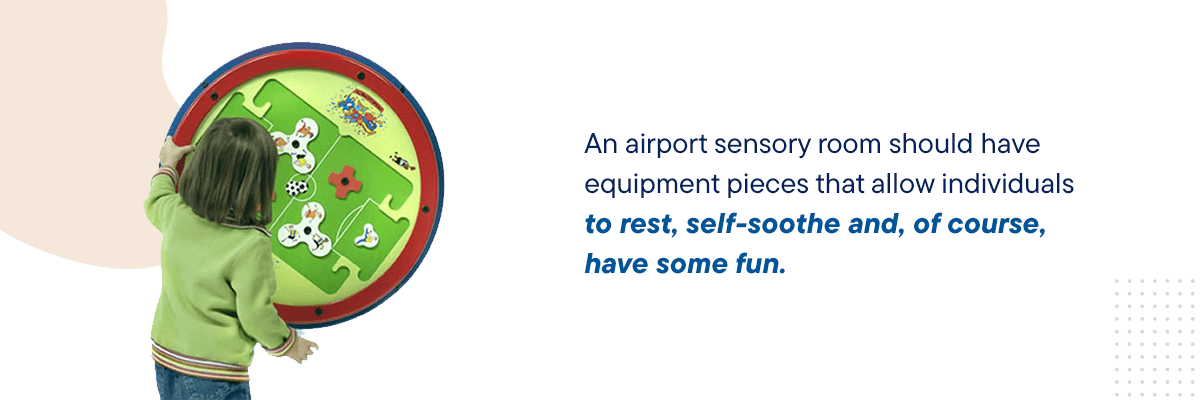
Typical playgrounds can be noisy and overstimulating for kids with ASD, so including features that engage multiple senses and bring a sense of controlled play makes a significant difference. Providing fun, stimulating pieces is essential, but it’s also helpful to provide quiet spaces for kids to recharge before they go back to play or get ready for a flight.
Airports with sensory rooms should also serve as safe spaces where individuals with autism can mentally prepare to enter shops, gates and flights. Where possible, include a sensory map that offers alternate routes through the airport that are typically quieter or less busy.
The following equipment pieces can help create a sensory room that offers sufficient stimulation and relaxation for different senses:
- Auditory: Incorporating musical elements like the Tap-A-Tune panels can offer auditory stimulation and help kids calm their senses by focusing on interacting with the equipment.
- Tactile: Touching different textures and equipment pieces stimulates the tactile sensory system. It helps kids engage with more senses to relieve anxiety and focus on the moment.
- Visual: Different colors and themed sculptures can offer visual engagement that keeps kids entertained. They may help reduce sensory overload by providing visual cues on which to focus.
- Vestibular: Kids can engage their vestibular senses through equipment like commercial indoor slides. These allow them to slide their bodies through the bends and curves, stimulating the balance system.
When looking for equipment, choose options that are easy to maintain. For example, Soft Play equipment is easy to clean and most parts can be wiped with water and mild soap. There are also antimicrobial play elements available, like the Elementz line, which can be particularly useful in a busy area like an airport. The products also come with a defect-free warranty, reflecting confidence in quality.
What Are the Accessibility Guidelines for Sensory Rooms?
When adding sensory rooms to airports, it’s important to ensure that they’re inclusive and accessible for individuals of diverse abilities. People with mobility devices should be able to access the room. The Americans with Disabilities Act (ADA) highlights the significance of floor surfacing in enhancing accessibility. Rubber mats and tiles are perfect options to include in the sensory room, making it easier for people with mobility devices to move around.
Several other principles of accessible design are guided by the ADA:
- Adequate Size and Space for Approach and Use: There should be enough space and clear pathways for kids and adults with mobility devices to access all parts of the area.
- Perceptible Information: Provide visual and auditory cues that clearly explain playground features.
- Equitable Use: The space and features should be accessible and useable for people of different abilities.
- Tolerance for Error: The space should be designed with tolerance for potential mistakes that kids might make.
- Simplicity and Intuitiveness: The area should be easy to navigate and shouldn’t require complex instructions.
- Minimal Physical Effort: Playground features should require minimal effort, making them suitable for kids with different abilities.
- Flexibility in Use: Activities should be enjoyable for kids of different abilities.
How Soft Play Can Help Create Sensory Rooms
Soft Play can create an airport sensory room that’s inclusive, accessible and packed with equipment to stimulate and calm the senses. We can develop kid- and adult-friendly sensory rooms that align with your company branding or preferred theme. If you already have an indoor playground, we can help you make it more inclusive for people with sensory difficulties by adding in soft play materials or building a quiet zone.
Soft Play can create sensory rooms that offer a range of inclusive, sensory-friendly features like tactile elements that incorporate different shapes and textured paths to stimulate the senses. We also include visual and auditory stimuli through musical components and vibrant colors, providing varied sensory experiences. Our builds can also include calming, quiet spaces with comfortable soft seating for tired and overwhelmed kids.
Build Tranquil Airport Sensory Rooms With Soft Play
At Soft Play, we have been building structural playground equipment for decades, and we are the industry leader in custom play solutions. Whether you want to add a sensory room or quiet zone to your existing playground or build a playground that serves as a safe space for kids with sensory difficulties, we can make it happen. We offer free design consultations to help you create the space that represents your company and aligns with your existing architectural accents.
All our products are handcrafted in the USA, and we exceed all safety and accessibility standards for every project. We also perform routine maintenance checks and repairs, giving you total peace of mind.
Request a quote today or contact us to learn more about how we can help your business with a custom play solution.
